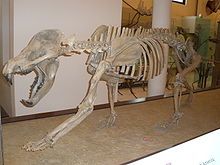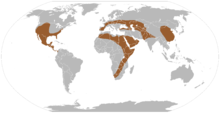Amphicyonidae
| Amphicyonids | |
|---|---|

| |
| Skeleton of Amphicyon | |
| Scientific classification | |
| Domain: | Eukaryota |
| Kingdom: | Animalia |
| Phylum: | Chordata |
| Class: | Mammalia |
| Order: | Carnivora |
| Suborder: | Caniformia |
| Superfamily: | †Amphicyonoidea |
| Family: | †Amphicyonidae Haeckel, 1866 |
| Subfamilies | |
|
†Amphicyoninae | |
Amphicyonidae is an
Taxonomy

The family was erected by Haeckel in 1866 (also attributed to Trouessart 1885). Their exact position has long been disputed. Some early paleontologists defined them as members of the family Canidae, but the modern consensus is that they form their own family. Some researchers have defined it as the sister clade to ursids (bears), based on morphological analysis of the ear region.[2][1] However, cladistic analysis and reclassification of several species of early carnivore as amphicyonids has strongly suggested that they may be basal caniforms, from lineages older than the origin of both bears and dogs.[3][4][5]
Description
Amphicyonids ranged in size from as small as 5 kg (11 lb) and as large as 100 to 773 kg (220 to 1,704 lb)[6] and evolved from wolf-like to bear-like body forms.[7]
Early amphicyonids, such as Daphoenodon, possessed a digitigrade posture and locomotion (walking on their toes), while many of the later and larger species were plantigrade or semiplantigrade.[8] The amphicyonids were obligate carnivores, unlike the Canidae, which are hypercarnivores or mesocarnivores.[9]
There is often some confusion with the similar looking (and similarly named) "dog-bears", a more derived group of caniforms that is sometimes classified as a family (
Evolution

It has long been uncertain where amphicyonids originated. It was thought that they may have crossed from Europe to North America during the Miocene epoch, but recent research suggests a possible North American origin from the miacids Miacis cognitus and M. australis (now renamed as the genera Gustafsonia and Angelarctocyon, respectively). As these are of North American origin, but appear to be early amphicyonids, it may be that the Amphicyonidae actually originates in North America.[3]
Other New World amphicyonids include the oldest known amphicyonid, Daphoenus (37–16 Mya).
Amphicyonids began to decline in the late Miocene, and disappeared by the end of the epoch. The exact reasons for this are unclear. The most recent known amphicyonid remains are teeth known from the Dhok Pathan horizon, northern Pakistan, dating to 7.4-5.3 mya.[10] The species is classically named Arctamphicyon lydekkeri, which may actually be synonymous with a species of Amphicyon.[11]
Fossils of juvenile
Classification
Family Amphicyonidae
| Not assigned to a subfamily | Subfamily Amphicyoninae | Subfamily Haplocyoninae (Eurasia)[14][15] |
Subfamily Daphoeninae (North America) |
Subfamily Temnocyoninae (North America)[16] |
Subfamily Thaumastocyoninae[17] |
|---|---|---|---|---|---|
|
|
|
|
|
|
References
- ^ ISBN 9780231135283.
- from the original on 2023-09-04. Retrieved 2023-07-06.
- ^ from the original on 2016-10-14. Retrieved 2016-10-13.
- S2CID 86236545. Archived from the original (PDF) on July 20, 2007.)
{{cite book}}:|journal=ignored (help - S2CID 86235694.
- ^ Sorkin, B. 2008: A biomechanical constraint on body mass in terrestrial mammalian predators. Lethaia, Vol. 41, pp. 333–347.
- ^ Jacobs, Louis L. Jacobs; Scott, Kathleen Marie: Evolution of Tertiary Mammals of North America: Terrestrial carnivores, Cambridge University Press, 1998
- ^ Wang, Xiaoming and Tedford, Richard H. Dogs: Their Fossil Relatives and Evolutionary History. New York: Columbia University Press, 2008. p10-11, 29
- ISBN 978-0-521-35519-3.
- JSTOR 24106648.
- .
- S2CID 214431583.
- S2CID 214431583.
- ^ S2CID 204264754.
- from the original on 2023-04-06. Retrieved 2023-02-18.
- ^ Hunt, Robert (2011-01-01). "Evolution of large carnivores during the mid-Cenozoic of North America: The Temnocyonine Radiation (Mammalia, Amphicyonidae)". Papers in the Earth and Atmospheric Sciences. Archived from the original on 2023-03-26. Retrieved 2023-04-07.
- (PDF) from the original on 2022-08-14.
- .
- ^ S2CID 220714559.
- ^ Ginsburg, Léonard (2002). "Un Amphicyonidae (Carnivora, Mammalia) nouveau du Miocène moyen de Vieux-Collonges (Rhône)". Symbioses (in French). 7: 55–57.
- ^ from the original on 2023-04-09. Retrieved 2023-05-01.
- S2CID 224860287.
- S2CID 229196919.
- ^ Wang, Xiaoming; Hong-jiang, Wang; Jiangzuo, Qigao (2016). "New record of a haplocyonine amphicyonid in early Miocene of Nei Mongol fills a long-suspected geographic hiatus". Vertebrata PalAsiatica. 54 (1): 21–35.
- from the original on 2022-11-27. Retrieved 2023-05-01.
- from the original on 2023-05-26. Retrieved 2023-05-18.
- S2CID 73677723.
- ^ a b c Morales, Jorge; Pickford, Martin (2022). "The taxonomic status of "Ysengrinia" ginsburgi Morales et al. 1998 (Amphicyonidae, Carnivora) from the basal middle Miocene of Arrisdrift, Namibia" (PDF). Communications of the Geological Survey of Namibia. 24: 1–16. Archived (PDF) from the original on 2023-04-05. Retrieved 2023-05-01 – via Google Scholar.
- (PDF) from the original on 2023-09-04. Retrieved 2023-07-06.
- from the original on 2023-12-19. Retrieved 2023-05-09.
- S2CID 146620949.
- ^ Morales, Jorge; Pickford, Martin (2022). "The taxonomic status of "Ysengrinia" ginsburgi Morales et al. 1998 (Amphicyonidae, Carnivora) from the basal middle Miocene of Arrisdrift, Namibia" (PDF). Communications of the Geological Survey of Namibia. 24: 1–16. Archived (PDF) from the original on 2023-04-05. Retrieved 2023-05-01 – via Google Scholar.
- from the original on 2023-04-18. Retrieved 2023-05-01.
- S2CID 85904748.
